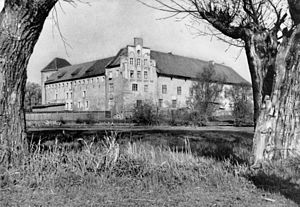Labiau Castle
| Labiau Castle | ||
|---|---|---|
|
Labiau Castle |
||
| Creation time : | 1258 to 1259 | |
| Castle type : | Location | |
| Conservation status: | reconstructed | |
| Standing position : | Ordensburg | |
| Place: | Pavlovo | |
| Geographical location | 54 ° 51 '44.3 " N , 21 ° 6' 55.5" E | |
|
|
||
The castle Labiau was an important Ordensburg of the Teutonic Order in the then East Prussian city Labiau today Polessk . It is still partially preserved today.
history
The wooden castle Labiau was built after the conquest of the Samland between 1258 and 1259. It was supposed to protect Königsberg from enemies approaching across the Curonian Lagoon . In 1277 the Schalauer burned it down. After that it was rebuilt again and again, most recently in 1360 as a four-winged water castle made of stone, which was located on an island and formed a horseshoe-shaped moat together with the Deime. In the 14th century the Ordensburg was a gathering point for the warlike "journeys" against the pagans in Schalau and Nadrau. In 1352 Heinrich Schindekopf won over the Lithuanians.
After the secularization of the religious order , Duke Albrecht made the castle the seat of a main office and gave it to his first wife Anna Sophia of Prussia in 1526 . Fires broke out in 1548 and 1552, which presumably destroyed the west wing. After the renovation by Christoph Römer , Albrecht's second wife Anna Maria von Braunschweig-Calenberg-Göttingen lived in the building from 1565 to 1568. Also Friedrich Wilhelm, the Great Elector , lingered here like when he went into the woods to hunt. Here he concluded the Treaty of Labiau with the Swedes; from here he undertook his famous hunt across the Curonian Lagoon . A relief of the Great Elector carved in stone in the wall with the text of the treaty reminded of the treaty. The castle's chapter house, where the treaty was signed, still existed in 1832.
From 1860 the castle was the seat of the district court with prison and the district office. Finally a local museum was set up. In World War I , there was a fire in 1917.
After the Second World War , the castle was a prisoner of war camp, from 1948 a prison, grain shop and bread bakery; restoration workshops emerged.
In 1965 the castle burned down completely. A collection of 30,000 photographic films with images of East Prussian cultural monuments, which had been moved here from Königsberg at the beginning of January 1945, was destroyed.
literature
- Tomasz Torbus: The convent castles in the Teutonic Order of Prussia . Oldenbourg, Munich 1998, ISBN 3-486-56358-0 , pp. 221-224, 446-471, doi: 10.11588 / diglit.43361 .


